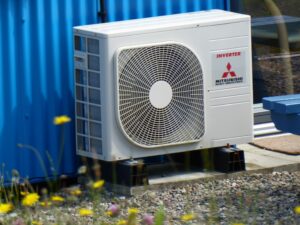
A hint of good news in my blog today, partially inspired by a talk I attended by Chris Stark, the Chief Executive of the Climate Change Committee. The falling cost of solar pv, wind and batteries will decimate the business models of fossil fuel electricity generation. Here is how this might play out.
We often hear of climate tipping points. Like a children’s see-saw, a small change can tip the see-saw into a new state. Invariably climate tipping points are bad news, where a slow change suddenly tips or accelerates into an environmental catastrophe. However, there are also many technology tipping points; slow adoption of a new product, then acceleration until everybody takes advantage of the new technology. Mobile phones are a good example.
We are on the cusp of a global technology tipping point for renewable electricity generation. This will result in a rapid transition from fossil fuel powered generation to renewables.
The cost of solar pv, wind power and batteries has been declining at 10% per year for the last two decades. In recent years deployment of renewables has consistently been faster than predicted by the International Energy Agency. These cost reductions are expected to continue brought about by a mixture of innovative technology, supportive government policies, greater experience in deployment and manufacturing economies of scale as they are rolled out at an ever-faster pace.
Meanwhile the cost of fossil fuel is unstable, volatile and is subject to external shocks. Most is imported. After adjusting for inflation, the cost is not dissimilar to that of one hundred years ago. Improved efficiencies in extraction have been offset by depletion of the most productive and accessible resources.
Taking these two together, electricity generated by renewables will soon be much cheaper than that produced from fossil fuels. This is happening now. This is game changing given many politicians have told us that we must delay as we cannot afford green policies.
In broad terms there are four stages in this revolution:
- Initially, new renewable technologies are subsidised, and this adds cost to bills
- Subsidies are removed, and renewables compete on a level playing field
- Renewables undermine the business case to invest in new fossil fuel power stations
- Renewables undermine the business case to operate existing fossil fuel power stations
Examples of all four stages abound which shows how close we are to this revolution.
- I bought 2.2kwp of solar pv for my roof in 2010 for £10,000, paid for by a generous feed in tariff subsidy. Today you can install 4kwp of solar pv for £5,000.
- The last coal power station built in Great Britain was Drax, opened in 1974 and extended in 1986. In 2008, 80% of the UK’s electricity was generated from coal; this will fall to zero in October 2024 when the last coal station is due to close. These closures were accelerated by carbon taxes but were inevitable over time in any case.
- The last gas-powered station built was Keadby in 2023, and it is unlikely that any more will be built.
It looks like offshore wind will squeeze out gas over the coming decade. The operational running cost of renewables is extremely low (the fuel is free), therefore gas power stations are increasingly only deployed on days when it is not windy and to provide specialist auxiliary services. As more offshore wind is built, gas power stations will be paid lots of money to tick over for occasional use. This will continue until large scale storage is built (perhaps using hydrogen).
There is a strange situation today in the UK. No-one will invest in large scale electricity generation without a subsidy or price guarantee. On-shore wind is now the technology that requires the least subsidy which is a real and significant change. Meanwhile householders and businesses are choosing to deploy solar without any subsidy. 190,000 householders installed solar pv in the UK in 2023 and we are hardly the sunniest part of the world. With this glut of ‘free’ energy in the summer months the price of electricity can fall dramatically at times and further undermine the business models of fossil fuel generators.
But this is just the beginning. As the price of solar and wind continue to fall, coal and gas power stations will become hopelessly uneconomic across the world. The biggest impact may be in China and India with their large number of coal power stations. These will become a large, scattered herd of ‘white elephants’. Some will limp on to provide power when it is not sunny, but most will close. Many will fall into bankruptcy – leaving a dirty legacy to clear up.
So why are global carbon emissions not falling when the deployment of electricity from renewables is soaring? So far, renewable energy is simply keeping up with the increase in global electricity demand. With continued accelerated deployment, renewable electricity will begin to displace fossil fuels.
But new coal power stations are still being built I hear you say. Yes, but I bet none are being financed fully by private investors as they are concerned that they will never be profitable. India is building coal power stations to enhance its energy security. Other countries still finance new coal power stations, but the main motivation is to help their domestic manufacturers of turbines and other components to export and win huge contracts. More hopefully, in 2022, China announced that it would no longer finance new coal power stations overseas. Another step forward.
Conclusions
The cost of renewable energy continues to fall and has recently become cheaper than energy from fossil fuels. Soon it will be much cheaper, which will undermine the business model of fossil fuel generators. This will happen at different times in different places but can be accelerated by supportive government policies.
The happy result, at last, will be a plateau, then a rapid reduction in carbon emissions from the electricity sector across the world. There will be a further benefit as falling electricity emissions will reduce the environmental impact of newly electrified sectors such as electric vehicles and the heating and cooling of buildings. Good news at last.
If you like this blog, please share it with your friends and on social media.
Carbon Choices
Don’t miss my future blogs! Please email me at This email address is being protected from spambots. You need JavaScript enabled to view it. and I will send you each new blog as I publish them.
You might also enjoy my book, Carbon Choices on the common-sense solutions to our climate and nature crises. Available direct from me here. I am donating one third of profits to rewilding projects.
Follow me:
@carbonchoicesuk (twitter) @carbonchoices (Facebook) @carbonchoices (Instagram)
- SEO Powered Content & PR Distribution. Get Amplified Today.
- PlatoData.Network Vertical Generative Ai. Empower Yourself. Access Here.
- PlatoAiStream. Web3 Intelligence. Knowledge Amplified. Access Here.
- PlatoESG. Carbon, CleanTech, Energy, Environment, Solar, Waste Management. Access Here.
- PlatoHealth. Biotech and Clinical Trials Intelligence. Access Here.
- Source: http://www.carbonchoices.uk/index.php/blog/blog-55
- :has
- :is
- :not
- :where
- $UP
- 000
- 2%
- 2008
- 2010
- 2022
- 2023
- 2024
- a
- About
- accelerated
- accelerates
- acceleration
- accessible
- across
- address
- Adds
- adjusting
- Adoption
- ADvantage
- After
- agency
- ago
- All
- also
- am
- an
- and
- announced
- Another
- any
- ARE
- AS
- At
- auxiliary
- available
- Bad
- Bankruptcy
- batteries
- BE
- become
- been
- begin
- Beginning
- being
- benefit
- Bet
- Biggest
- Blog
- book
- bought
- britain
- broad
- brought
- Building
- built
- business
- business model
- businesses
- but
- by
- CAN
- cannot
- carbon
- carbon emissions
- case
- change
- changing
- cheaper
- chief
- Chief Executive
- China
- choices
- choosing
- Chris
- clear
- Climate
- Climate change
- Close
- Coal
- coming
- committee
- compete
- components
- concerned
- consistently
- continue
- continued
- continues
- contracts
- Cost
- countries
- crises
- Cusp
- Days
- decade
- decades
- Declining
- delay
- Demand
- deploy
- deployed
- deployment
- different
- direct
- Domestic
- donating
- dramatically
- due
- each
- economies
- Economies of Scale
- efficiencies
- Electric
- electric vehicles
- electricity
- Emissions
- enabled
- energy
- enhance
- enjoy
- environmental
- everybody
- example
- executive
- expected
- experience
- export
- extended
- external
- extraction
- extremely
- Fall
- Falling
- far
- faster
- finance
- financed
- For
- Forward
- fossil
- Fossil fuel
- fossil fuels
- four
- Free
- friends
- from
- Fuel
- fuels
- fully
- further
- future
- game
- GAS
- generated
- generation
- generators
- generous
- given
- Global
- good
- Government
- great
- Great Britain
- greater
- Green
- guarantee
- happen
- Happening
- happy
- Have
- hear
- help
- here
- hint
- Hopefully
- How
- However
- http
- HTTPS
- huge
- hundred
- hydrogen
- i
- Impact
- improved
- in
- Increase
- increasingly
- india
- inevitable
- inflation
- innovative
- innovative technology
- inspired
- install
- International
- into
- invariably
- Invest
- Investors
- IT
- ITS
- JavaScript
- jpg
- just
- keeping
- large
- Last
- least
- leaving
- Legacy
- Level
- like
- longer
- LOOKS
- lots
- Low
- Main
- Manufacturers
- manufacturing
- many
- May..
- me
- Meanwhile
- Media
- might
- miss
- mixture
- Mobile
- mobile phones
- model
- models
- money
- months
- more
- most
- Motivation
- much
- must
- my
- Nature
- Need
- never
- New
- new product
- newly
- news
- no
- None
- now
- number
- occasional
- october
- of
- offset
- often
- on
- ONE
- only
- opened
- operate
- operational
- or
- Other
- our
- out
- over
- overseas
- Pace
- paid
- part
- per
- perhaps
- phones
- Places
- plato
- Plato Data Intelligence
- PlatoData
- Play
- playing
- please
- Point
- points
- policies
- Politicians
- power
- powered
- predicted
- price
- private
- Produced
- Product
- productive
- profitable
- profits
- projects
- protected
- provide
- publish
- rapid
- real
- recent
- recently
- reduce
- reduction
- reductions
- Removed
- Renewable
- renewable energy
- Renewables
- requires
- Resources
- result
- Revolution
- Rolled
- roof
- running
- say
- Scale
- scattered
- sector
- Sectors
- security
- send
- Services
- Share
- Shows
- significant
- simply
- situation
- slow
- small
- So
- so Far
- soaring
- Social
- social media
- solar
- Solutions
- some
- Soon
- specialist
- Squeeze
- stages
- stark
- State
- station
- Stations
- Step
- Still
- storage
- strange
- subject
- subsidy
- such
- summer
- supportive
- takes
- Talk
- Taxes
- Technologies
- Technology
- terms
- than
- that
- The
- the UK
- the world
- their
- Them
- then
- There.
- therefore
- These
- they
- Third
- this
- tick
- time
- times
- tip
- Tipping
- Tipping point
- tips
- to
- today
- together
- told
- transition
- two
- Uk
- Undermine
- unlikely
- until
- us
- use
- using
- Vehicles
- View
- volatile
- was
- we
- were
- when
- which
- why
- will
- win
- wind
- wind power
- with
- without
- world
- would
- year
- years
- yes
- you
- Your
- zephyrnet
- zero












